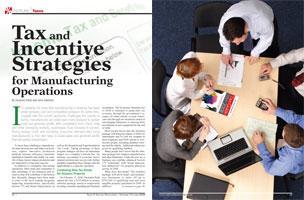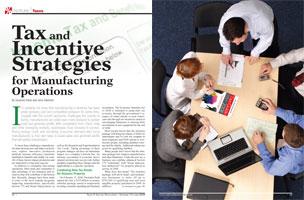

It’s certainly not news that manufacturing in America has been under growing cost and competitive pressure for some time. Coupled with the current economic challenges the country is facing, manufacturers are under even more pressure to contain costs and generate profits. With competition from China, India and other emerging markets, businesses must innovate to survive. Rising energy costs and shrinking consumer demand also force manufacturers to find new ways to boost sales and generate profits that will satisfy shareholders.
To meet these challenges, manufacturers must develop new and improved products, explore innovative production methods, increase efficiency, maximize distribution channels and simply cut costs. All of these factors impact production and are important to long-term success.
In addition to constantly fine-tuning operations, firms must also remember to take advantage of tax strategies and incentives that will contribute to the bottom line. Recently, changes have been made to some of the more popular programs impacting manufacturers, specifically Section 179 and Bonus Depreciation, as well as the Research and Experimentation Tax Credit. Taking advantage of these program changes can have an immediate impact on a company’s bottom line. An attorney, accountant or economic development professional can provide further guidance regarding these changes and the applicability to a specific operation.
Combining New Tax Breaks for Business Property
On February 13, 2008, President Bush signed into law a $152-billion economic stimulus package aimed at temporarily boosting consumer spending and business investment. The Economic Stimulus Act of 2008 is intended to jump-start our economy through the government's issuance of rebate checks to most Americans and through tax incentives aimed at encouraging businesses to increase their investments in new equipment by the end of 2008.
Most people know that the stimulus package will bring tax rebates of $600 for individuals and $1,200 for couples to most taxpayers and $300 checks to low-income people, including disabled veterans and the elderly. Additional rebates are given for qualifying children.
Many people don’t know that the stimulus package also impacts manufacturers and other businesses. Under the new act, a business can combine enhanced Section 179 “expensing” with “bonus depreciation deductions” for property placed in service in 2008.
What does this mean? The stimulus package will allow small- and medium-size businesses to write off up to $250,000 of qualifying new and used tangible property purchased in 2008. In addition, businesses will be able to write off an additional 50 percent of the cost of new equipment placed in service by the end of 2008. The otherwise applicable luxury auto cap on first-year depreciation is increased by $8,000 for vehicles that qualify.
Boosted Section 179 Expensing
Under pre-Act law, taxpayers can expense (i.e., deduct currently, as opposed to taking depreciation deductions over a period of years) up to $128,000 for 2008. This annual expensing limit is reduced (but not below zero) by the amount by which the cost of qualifying property placed in service during 2008 exceeds $510,000. The amount of the expensing deduction is limited to the amount of taxable income from any of the taxpayer's active trades or businesses. Under the Economic Stimulus Act of 2008, for tax years beginning in 2008, the $128,000 expensing limit is increased to $250,000, and the overall investment limit is increased from $510,000 to $800,000. These figures will revert to their previous levels for 2009 and 2010.
As a result of this incentive, most small businesses, and even some moderate-sized businesses with moderate capital equipment needs, will be able to obtain a full deduction for the cost of business machinery and equipment purchased in 2008, thereby reducing their effective cost for those assets. What's more, there is no alternative minimum tax (AMT) adjustment with respect to property expensed under Code Sec. 179.
Bonus Depreciation Makes a Comeback
Bonus first year depreciation was first allowed following the terrorist attacks of 2001 but generally isn't available for property acquired after 2004. (There are some exceptions, such as for qualified GO Zone property generally placed in service before 2008.)
The Economic Stimulus Act of 2008 provides for bonus (accelerated) depreciation by allowing a bonus first-year depreciation deduction of 50 percent of the adjusted basis of qualified property placed in service after December 31, 2007, and, generally, before January 1, 2009. The basis of the property and the depreciation allowances in the year the property is placed in service and later years are appropriately adjusted to reflect the additional first-year depreciation deduction. The amount of the additional first-year depreciation deduction is not affected by a short taxable year. The taxpayer may elect out of additional first-year depreciation for any class of property for any taxable year. Bonus depreciation is allowed for AMT purposes as well as for regular tax purposes. Original use of the property must begin with the taxpayer after December 31, 2007.
For this purpose, qualified business property includes:
Property with a cost recovery period of 20 years or less
Depreciable software that is depreciable over three years
Qualified leasehold improvements, and
Water utility property.
Bonus depreciation may also extend through 2009 for qualifying property. This includes property with a cost recovery period of 10 years or longer, certain transportation equipment and certain aircraft.
After Section 179 expensing is combined with bonus depreciation, the regular rules for depreciation are applied to the balance under the Modified Accelerated Cost Recovery System (MACRS). Deductions are claimed in this order: Section 179 deduction, bonus depreciation deduction and then MACRS deduction.
Example
For simplicity, assume that XYZ Company buys five-year property costing $500,000 and places it in service in 2008. Under Section 179, XYZ is entitled to a maximum deduction of $250,000. It can then claim bonus depreciation of $125,000 (50 percent of $250,000 balance). Finally, using the 20 percent, first-year deduction under MACRS, XYZ is entitled to an additional $25,000 deduction (20 percent of $125,000) in 2008.
This combination enables XYZ to deduct a total of $400,000 ($250,000 + $125,000 + $25,000) in 2008. The remaining $100,000 is available for MACRS deductions over the following four years.
Reminder: This is only a hypothetical example. Consult with a professional tax adviser concerning the maximum deductions available for a particular firm.
Getting Credit for R&D
The Research and Experimentation federal tax credit is designed to encourage manufacturing companies to make technological improvements to products and processes. The credit has been in effect since 1981. The credit is intended to offset the decreased spending by the federal government to support private research and development activities. It is also intended to increase the competitiveness of domestic manufacturers.
Most state governments have also enacted tax credits to encourage firms to conduct research within their state. Although the statutory rate to compute the credit varies from state to state, most states structure their credits after the federal tax credit for R&E expenses.
The credits are well-utilized. Each year manufacturers claim billions of dollars in federal and state tax credits by taking advantage of incentives to invest in research and development. Companies that are not taking advantage of these potentially lucrative tax savings, because they do not feel they qualify, often confuse what they define as research and development with what the IRS defines as research and experimentation.
The credit allows a company to claim credit for “qualified research expenditures” (QREs) –costs associated with investments in innovation and improvements that go well beyond product research and development. For example, investments made in process improvements may qualify, and many manufacturers invest far more in improving their processes than in developing products.
Having QREs is only part of the picture. The IRS subjects research tax credits to intense scrutiny, so detailed documentation demonstrating that each QRE meets the criteria is needed. An extensive case must be built prior to a company claiming the credit. The case should include a detailed explanation of the arguments for qualification and should provide all the necessary documentation in an easy-to-follow format.
Will Pursuing the Credit Pay Off?
If a company invests in advancing products or innovating processes, pursuit of the credit should yield significant current and future year tax savings, especially when combined with state tax credit programs. For example, an Indiana company that conducts these types of activities can obtain combined federal and state tax savings of up to 12 percent of their investment in developing new products or processes. This is a true tax credit (dollar-for-dollar reduction of tax), and not just a deductible expense. In addition to establishing this tax strategy going forward, the law generally allows a company to file amended federal and state income tax returns for the prior three years, so substantial refunds may also be available.
If a company has been taking the credit, or has previously decided not to, important changes that took place in 2007 should be carefully examined. First, the addition of a fourth calculation option was effective January 1st. The Alternative Simplified Credit allows companies to use the previous three years’ qualified research expenditures as a baseline for their current year credit. Previously, a company’s only option to qualify for the credit was determined based on a percentage of annual revenues. In many cases, this diluted the annual benefit due to substantial revenue growth. With the new calculation option, the revenue factor is removed allowing many fast-growing companies to claim larger credits.
Also in April 2007, the IRS released a directive stating that the scrutiny placed on R&E credit claims will increase. Now more than ever, the IRS and state regulatory agencies expect companies to perform due diligence in qualifying their research activities and gather the necessary documentation prior to claiming any research credits. A qualified CPA or tax professional, experienced with the credit, can be a valuable partner in this process.
Summary If a manufacturing company makes an investment in new facilities and equipment, or creates new jobs, the availability and applicability of tax credits and incentives should be examined. In addition to the programs discussed above, most states and municipalities also have programs available to support capital investment and job growth by private sector companies. While these programs can sometimes seem to be difficult to understand – or simply more work than they are worth – a qualified professional can quickly determine the costs and benefits. In most cases, the benefits clearly outweigh the costs.
